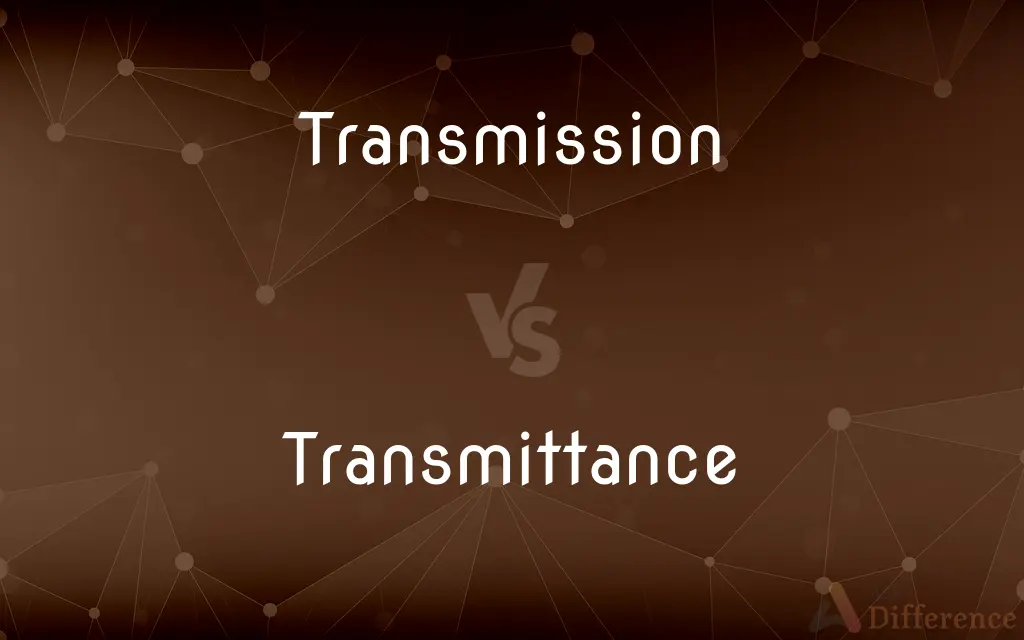Transmission vs. Transmittance — What's the Difference?
Edited by Tayyaba Rehman — By Fiza Rafique — Updated on March 10, 2024
Transmission refers to the process or act of passing something from one place to another, while transmittance is a measure of the amount of light that passes through a material compared to the light that hits it, often expressed as a percentage.

Difference Between Transmission and Transmittance
Table of Contents
ADVERTISEMENT
Key Differences
Transmission involves the act of conveying or transferring something from one place, person, or thing to another. It can apply to various contexts, including the spread of diseases, the transfer of energy, or the sending of data over a distance. Transmittance, however, specifically quantifies how much light or electromagnetic radiation is allowed to pass through a material, with the remainder being absorbed or reflected.
In physics and engineering, transmission is a broad concept that encompasses the movement of electromagnetic waves, particles, or information. It is not limited to light and can include other forms of energy, such as sound or electrical power. Transmittance is a more specific term, used primarily in optics and materials science to describe how transparent a material is to light or specific wavelengths of electromagnetic radiation.
Transmission efficiency can vary greatly depending on the medium and the energy form being transmitted. For example, electrical transmission lines can lose energy due to resistance and heat. Transmittance, on the other hand, is specifically concerned with the efficiency of light passing through a material and is calculated as the ratio of transmitted light to incident light, often affected by the material's thickness, composition, and the wavelength of the light.
While transmission can apply to both tangible and intangible entities (like power or information), transmittance is used to describe a physical property of materials that affects how light interacts with them. This makes transmittance an important factor in designing optical systems, choosing materials for lenses, filters, and windows, and understanding the behavior of light in different environments.
Both transmission and transmittance play critical roles in various technological and scientific fields, but they are applied differently. Transmission is crucial for communication systems, power distribution, and mechanical systems. Transmittance is key in optics, photonics, and materials science, influencing the development of products and technologies that rely on the control of light.
ADVERTISEMENT
Comparison Chart
Definition
The act of transferring something from one place to another.
The measure of light that passes through a material.
Contexts
Broad, includes energy, data, diseases.
Primarily used in optics and materials science.
Quantification
Can refer to efficiency or capacity.
Expressed as a ratio or percentage of light transmitted.
Dependency
Depends on medium and type of energy or information.
Depends on material properties and light wavelength.
Applications
Communication, power systems, mechanical systems.
Optical design, materials selection, photonics.
Compare with Definitions
Transmission
The process of sending electrical power across distances.
The transmission of electricity across national grids.
Transmittance
The ratio of light passing through glass compared to the incident light.
The transmittance of the window glass determines its brightness.
Transmission
Refers to the passage of light through an atmosphere.
Atmospheric transmission affects astronomical observations.
Transmittance
Measured as a percentage in materials science.
A high transmittance material is used for optical lenses.
Transmission
The spread of diseases from person to person.
Reducing the transmission of viruses is critical in public health.
Transmittance
Influences the efficiency of solar panels.
Transmittance affects how much sunlight reaches the solar cells.
Transmission
The sending of data or signals through a medium.
Wireless transmission technologies have revolutionized communications.
Transmittance
Critical in designing optical filters.
The filter's transmittance curve blocks harmful UV rays.
Transmission
Involving the movement of force in machinery.
The car's transmission ensures power reaches the wheels.
Transmittance
Determines the visibility through transparent materials.
Materials with 90% transmittance are nearly clear.
Transmission
The action or process of transmitting something or the state of being transmitted
The transmission of the virus
Transmittance
Transmittance of the surface of a material is its effectiveness in transmitting radiant energy. It is the fraction of incident electromagnetic power that is transmitted through a sample, in contrast to the transmission coefficient, which is the ratio of the transmitted to incident electric field.Internal transmittance refers to energy loss by absorption, whereas (total) transmittance is that due to absorption, scattering, reflection, etc.
Transmission
The mechanism by which power is transmitted from an engine to the axle in a motor vehicle
A three-speed automatic transmission
Transmittance
A transmission.
Transmission
The act or process of transmitting.
Transmittance
(Physics) The ratio of the radiant energy transmitted to the total radiant energy incident on a given body.
Transmission
The fact of being transmitted.
Transmittance
A transmission
Transmission
Something, such as a message, that is transmitted.
Transmittance
(physics) the fraction of incident light, or other radiation, that passes through a substance
Transmission
An assembly, as in a motor vehicle, that transmits power from an engine to a driving axle, usually having a manually or automatically adjustable mechanism to control the balance of power and speed. Also called gearbox.
Transmittance
Transmission.
Transmission
The sending of a signal, picture, or other information from a transmitter.
Transmittance
The fraction of radiant energy that passes through a substance
Transmission
The act of transmitting, e.g. data or electric power.
Transmission
The fact of being transmitted.
Transmission
Something that is transmitted, such as a message, picture, or a disease; the sending of such a thing.
Transmission
(biology) The passage of a nerve impulse across synapses.
Transmission
(automotive) An assembly of gears through which power is transmitted from the engine to the driveshaft in a motor car / automobile; a gearbox.
Transmission
(legal) The right possessed by an heir or legatee of transmitting to his successor(s) any inheritance, legacy, right, or privilege, to which he is entitled, even if he should die without enjoying or exercising it.
Transmission
(medicine, biology) The passing of a communicable disease from an infected host individual or group to a conspecific individual or group.
Transmission
The act of transmitting, or the state of being transmitted; as, the transmission of letters, writings, papers, news, and the like, from one country to another; the transmission of rights, titles, or privileges, from father to son, or from one generation to another.
Transmission
The right possessed by an heir or legatee of transmitting to his successor or successors any inheritance, legacy, right, or privilege, to which he is entitled, even if he should die without enjoying or exercising it.
Transmission
The mechanism within a vehicle which transmits rotational power from the engine to the axle of the wheel propelling the vehicle; it includes the gears and gear-changing mechanism as well as the propeller shaft.
Transmission
The process or event of sending signals by means of a radio-frequency wave from an electronic transmitter to a receiving device.
Transmission
The act of sending a message; causing a message to be transmitted
Transmission
Communication by means of transmitted signals
Transmission
The fraction of radiant energy that passes through a substance
Transmission
An incident in which an infectious disease is transmitted
Transmission
The gears that transmit power from an automobile engine via the driveshaft to the live axle
Common Curiosities
Why is transmission important in technology?
Transmission is crucial for the efficient delivery of power, data, and signals, essential for communication, power distribution, and mechanical operations.
How is transmittance measured?
Transmittance is measured as a ratio or percentage of the intensity of light that passes through a material compared to the incident light on it.
What factors affect transmittance?
Factors affecting transmittance include the material's composition, thickness, and the wavelength of the light.
Can transmission efficiency be improved?
Yes, by reducing losses due to resistance, absorption, or dispersion, depending on the type of transmission (e.g., electrical, mechanical, or optical).
Can transmission apply to non-physical entities?
Yes, transmission can also apply to the transfer of information, data, or diseases, not just physical entities like energy or light.
Is high transmittance always desirable?
Not always; the desired transmittance depends on the application, such as filters blocking harmful light or materials allowing for maximum light passage.
What is transmission in physics?
In physics, transmission refers to the process of transferring waves, particles, or energy from one point to another.
How does transmittance influence optical design?
Transmittance determines how much light passes through optical components, affecting the design of lenses, filters, and systems for specific light control requirements.
How do transmission and transmittance relate to energy efficiency?
Efficient transmission minimizes energy losses, while optimal transmittance can maximize the use of light in applications like solar energy and lighting.
What role does transmittance play in environmental science?
Transmittance can affect climate modeling and the study of atmospheric particles by influencing light absorption and scattering in the Earth's atmosphere.
Share Your Discovery

Previous Comparison
Stake vs. Bet
Next Comparison
Jesuit vs. CatholicAuthor Spotlight
Written by
Fiza RafiqueFiza Rafique is a skilled content writer at AskDifference.com, where she meticulously refines and enhances written pieces. Drawing from her vast editorial expertise, Fiza ensures clarity, accuracy, and precision in every article. Passionate about language, she continually seeks to elevate the quality of content for readers worldwide.
Edited by
Tayyaba RehmanTayyaba Rehman is a distinguished writer, currently serving as a primary contributor to askdifference.com. As a researcher in semantics and etymology, Tayyaba's passion for the complexity of languages and their distinctions has found a perfect home on the platform. Tayyaba delves into the intricacies of language, distinguishing between commonly confused words and phrases, thereby providing clarity for readers worldwide.















































